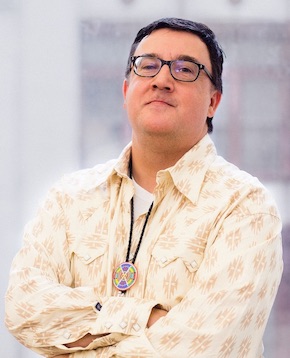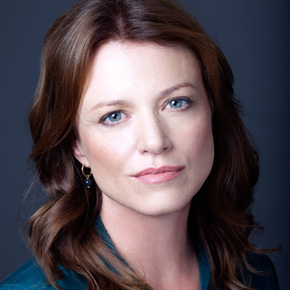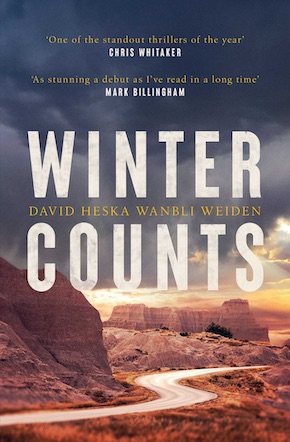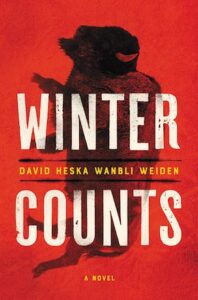David Heska Wanbli Weiden: See everything
by Karin SalvalaggioThe rolling hills of South Dakota’s vast Lakota tribal lands provide a stunning backdrop for David Heska Wanbli Weiden’s explosive debut novel Winter Counts. The opening scene is uncompromisingly violent. Virgil Wounded Horse is a vigilante for hire. Delivering justice for crime victims with his fists, he earns one hundred dollars for every injury he inflicts. The violence isn’t as gratuitous as it first seems. Men like Virgil serve a dark purpose. Tribal law enforcement agencies don’t have the authority to prosecute serious felonies committed on reservations, leaving perpetrators to walk free unless the federal government steps in, which doesn’t happen as often as it should. A sense of lawlessness prevails, which is all the more tragic because it is avoidable.
Virgil is a flawed protagonist whose complex journey is marked by a full range of emotions be they rage, love, passion or pride. Much has gone wrong in Virgil’s life, making him cling all the more tightly to everything that has gone right. When his nephew Nathan is targeted by drug dealers working for a cartel hoping to gain inroads on the Rosebud Reservation, a series of incidents are set in motion that take Virgil down a dangerous path. In order to survive both physically and spiritually, he will have to make peace with his cultural identity and learn to love again.
Winter Counts shines a much-needed spotlight on the boundless brutality and beauty found on America’s tribal lands. The depth of Lakota people’s cultural heritage is rich and largely untapped in mainstream literature, and Winter Counts provides a welcome correction. In highlighting both the injustices and the recent resurgence in Native American culture, the author walks a fine line between entertaining and educating the reader. This would be tricky for the most seasoned of writers. For the most part David steers this difficult path on his own terms, choosing to put aside the expected tropes and narrative forms to create something entirely unique.
Karin: Virgil Wounded Horse is a private enforcer living on the Rosebud Reservation. The role he plays in the community is grounded in a horrifying reality – felony crimes often go unprosecuted on tribal lands, leaving individuals to fend for themselves. As this is a key insight into Virgil’s character and the state of law enforcement on tribal lands, could you please take a moment to explain how the Major Crimes Act of 1885 has affected life on reservations?
David: Criminal justice on Native American reservations is exceptionally complicated. There are numerous laws – federal, state and tribal – that affect how and where crimes occurring on reservations are prosecuted. But the Major Crimes Act – passed by the US Congress in 1885 and still the law of the land – is certainly one of the most important. The law requires that serious felony crimes that are committed on Native reservations must be prosecuted by the FBI and the US Attorney in federal, not tribal courts. In other words, sovereign Native nations do not have the right to prosecute felony crimes on their own lands involving their own people. This is a tremendous violation of national sovereignty, but there’s much more to it.
By their own accounting, the FBI is declining to prosecute about 35% of these felony crimes on Native reservations. This means that the offender is released and is free to commit more crimes. Naturally, this encourages an atmosphere of lawlessness on reservations, and has spurred certain individuals – such as my fictional character Virgil Wounded Horse – to take matters into their own hands as hired vigilantes. In my novel, Virgil will administer a beating on one of these people – who may be child abusers or rapists – for the price of one hundred dollars for each bone he breaks and tooth he knocks out.
Although Virgil is fictional, the problem of inadequate administration of criminal justice on Indigenous lands is quite real. I’m frequently asked why the FBI is declining such a large percentage of these cases, but there’s no consensus among social scientists and legal experts as to the cause of this problem. One cause that nearly all agree upon is the fact that criminal justice is badly underfunded on Native reservations by the US government. Although there’s been some progress made on that front, more federal agents and other law enforcement officers are clearly needed.
I’m hoping that readers will leave the novel with a better understanding of the broken criminal justice system. But I also hope they come to understand more about Native people: our humour, resilience, creativity and sheer joyfulness.”
Winter Counts takes the reader places they’ve never been before and makes them see the world from a point of view that is largely unrepresented. The Australian author Sulari Gentill coined the saying, “Crime fiction is the new literature of resistance.” Did you have this resistance in mind when you wrote the novel? If so, what are the main points you’d like the reader to take away?
I love that quotation from Sulari so much! I’ve mentioned it often, always attributing it to her, of course. I certainly did have ‘the resistance’ in mind when I wrote the book. As a university professor, I’ve been studying and teaching these issues for years, and I wanted to fictionalise them in order to have a broader impact – as well as tell a great story.
I’m hoping that readers will leave the novel with a better understanding of the broken criminal justice system on reservations, our inadequate healthcare facilities, and the problem of providing healthy and sustainable foods on reservations. But I also hope that readers come to understand more about Native people: our humour, resilience, creativity and sheer joyfulness. I dedicated the book to the Sicangu Lakota people, and I hope I’ve done justice to them with my words.
It’s a debut that is as difficult to put down as it is to pin down. It is a crime novel, a thriller, a social commentary and an in-depth character-driven study all rolled into one. The writing also defies the expected narrative thrust normally found in a thriller, often going off on tangents: soulful, touristic, romantic, gastronomic and otherwise. It doesn’t feel accidental. Tell us a bit about how and why you chose to subvert the typical narrative structure that readers have come to expect.
I’m so pleased you noticed that! The somewhat transgressive narrative structure was very deliberate, and stems from my training in several different areas. I’m an attorney (although no longer practising) and also have a doctoral degree in political science, which involved studying history, culture – and politics, of course. And finally, I have a Master of Fine Arts in creative writing, where I studied both literary and genre fiction. I wanted Winter Counts to encompass all of these areas – legal, historical and cultural – but also paint a picture of modern Native society. Thus, I brought in the burgeoning Indigenous food movement, music, art, and fashion. Of course, the most important task was to create compelling characters and a plot that would keep readers turning the pages.
It was difficult to balance the educational and artistic elements, and earlier drafts of the novel had much more political content, such as a look at the broken juvenile justice system for Native Americans on reservations. But I chose to cut some of that material in order to maintain the narrative tension and keep the story and characters central in the book. I’m thrilled that readers and critics responded so positively to the plot and characters as well as the cultural, legal and political elements. I’ve received hundreds of lovely messages from fans around the world, and that’s been tremendously gratifying. My hope is that the novel has opened the eyes of readers who weren’t previously aware of these issues and controversies.
I see Virgil as wanting to move beyond his vigilantism and serve the community in a different way. But it’s not easy to make such a fundamental change, and the next book will depict this.”
I love books that leave you thinking long after the final page is turned, and this is one of them. Winter Countscovers a lot of ground culturally, literarily and geographically. Were you aware of just how much you were taking on when you started writing? Did you feel pressure to represent Native American culture and life on tribal lands in a specific way?
I felt a huge amount of pressure to write about the Sicangu Lakota people and culture in an accurate but positive way. I absolutely didn’t want to employ the tired stereotypes about Native people that have existed for decades, but neither did I want to create some overly optimistic and false depiction of reservation life. I often felt I was walking a tightrope, and I had some Native writers look at my work to reassure me that I’d hit the right balance. I’m happy to say that the response from Native readers and critics has been uniformly positive. They seem to share the view that the book depicts the challenges of reservation life but also the positive aspects of our culture and people.
Virgil is prone to deep soulful reflection but shuns tribal traditions. He’s capable of love but doesn’t see himself as lovable. He loses control when he’s at his most violent, yet he’s also a man who’s managed to keep his sobriety in check and care for his orphaned nephew. Virgil’s character arc dominates the novel. Much is resolved but I sense there’s more to explore. Will we be hearing more from Virgil in future novels? How do you see him developing over time?
Yes, there will be another Virgil Wounded Horse novel! I can’t say too much at this point, but I will share that, in the new book, Virgil has stopped serving as a professional vigilante but is struggling mightily with the change. I hinted at this in several short stories which I published in 2021: ‘Skin’, in the anthology Midnight Hour, and ‘Turning Heart’, which first appeared in This Time for Sure and will be reprinted in the 2022 edition of The Best American Mystery and Suspense Stories. Overall, I see Virgil as wanting to move beyond his vigilantism and serve the community in a different way. But it’s not easy to make such a fundamental change, and the next book will depict this. And I should note that the other major characters – Marie and Nathan – will each have their own journeys. I’ve been having a great time with the new book and can’t wait to share it with readers.
Marie Short Bear plays an interesting role in the novel. She softens Virgil’s character and provides a counterpoint to his views. She’s “tradish” with “super Indian qualifications” having shunned Dartmouth to study at the tribal college. She doesn’t seem to have any issues bridging the gap between the modern world and tribal traditions. She’s keen on combining modern medicine and indigenous healing practices. I have the sense that her character may have grown as the book developed. I’d love to hear more about the inspiration behind Marie.
Indeed, I worked on the character of Marie more than any other. In early drafts of the novel, Marie was flat, by which I mean that she didn’t display enough of the complexities and contradictions that define great characters. I worked hard to give her a unique arc and also some idiosyncrasies and flaws. Many people love her back story of wearing plastic wolf ears in school and howling all day. That anecdote came from my son, David Jr. He told me about a young girl at his elementary school who did just that, and I was charmed by the story. I exaggerated it in the book, of course, but it was fun to include it. Other parts of Marie’s character came from my own relationships with strong Native women, who often struggle to reconcile Indigenous values with modern practices and principles. I’ll close by noting that when Marie returns in the next book she’ll be running for election to the tribal council, which opens up a whole host of problems and issues.
I love that you pepper the text with a wealth of Lakota words and phrases – wakanheja, iyeska, wacantognaka, ina, ik, hoka, wasicu, peji, kiksuyapi, yuwipi, eyapaha, leksi, mitakuye oyasin, wakan Tanka nici un, and one of my personal favourites, akita mani yo, which means ‘see everything as you go’. It was usually possible to guess the meaning of the word or phrase using context, but other times I had to look up the meaning. Is Lakota still widely spoken among the younger generations or does it risk becoming a lost language? Some of the words, such as iyeska, are considered derogatory. I’m curious to know whether it is a word that should be avoided.
The Lakota language is not widely spoken among many younger people, sad to say. It is most certainly endangered, but I’m happy to report that there are many exciting new language initiatives springing up on my reservation and elsewhere, including the Lakolya Waoniya Language Revitalization Program, which just started in 2022. I’m not fluent in the language myself, but I work on it when I have some free time (which is not often). The study of the language is complicated by the fact that there are several orthographies in use by different reservations. I chose to use the simplest system, as I believed it was the most approachable for those not familiar with the language.
As for the word iyeska, it used to mean ‘translator’, but has come to take on the meaning ‘half-breed’. Yes, it is a word that can be considered offensive in a certain context, as Virgil notes in the book.
I’m excited at the prospect of an Indigenous food renaissance but as I’m living in the United Kingdom, the chances of having a taste are slim. I’d love to believe that such a renaissance exists in the real world. If so, can you recommend any chefs, restaurants and cookbooks?
Yes, I read that Sean Sherman’s Minneapolis restaurant, Owamni, recently won the James Beard Award for best new restaurant. And I’ve heard great things about the cookbook New Native Kitchen: Celebrating Modern Recipes of the American Indian by Freddie Bitsoie and James O. Fraioli. And I’d be remiss if I didn’t mention Tocabe, a fast-casual restaurant here in Denver that serves fantastic Indigenous food. Overall, Native cuisine is undergoing a huge renaissance here in the US, and it’s been a long time coming.
But I should conclude by observing that there seems to be an overall resurgence in Native American culture happening now. There have been many wonderful new films, television shows, books and music released in the last five years. It’s a great time for Native creativity, and I hope it continues.
 David Heska Wanbli Weiden is the first Native American author to win an Anthony Award and the Thriller Award, and the second to be nominated for the Edgar Award. His short fiction has appeared in numerous anthologies. Winter Counts is out now in paperback from Simon & Schuster, and also available in eBook and audio download.
David Heska Wanbli Weiden is the first Native American author to win an Anthony Award and the Thriller Award, and the second to be nominated for the Edgar Award. His short fiction has appeared in numerous anthologies. Winter Counts is out now in paperback from Simon & Schuster, and also available in eBook and audio download.
Read more
davidweiden.com
@WanbliWeiden
@simonschusterUK
Author portrait © Aslan Chalom
 Karin Salvalaggio is the author of the Macy Greeley crime novels Bone Dust White, Burnt River, Walleye Junction and Silent Rain and a contributing editor at Bookanista. Her fiction to date is set in towns that border the Montana’s wilderness, a uniquely spectacular landscape she fell in love with as a child. Her proudly independent characters inhabit stories about the American dream gone wrong. She is currently working on a crime novel set in California. Jessica Carson has returned to her conservative roots after working as a cop in Berkeley, one of America’s most liberal cities. The transition is not without difficulties. The police detective she’s replacing was involved in the 6 January riots and her estranged son has become immersed in Antifa.
Karin Salvalaggio is the author of the Macy Greeley crime novels Bone Dust White, Burnt River, Walleye Junction and Silent Rain and a contributing editor at Bookanista. Her fiction to date is set in towns that border the Montana’s wilderness, a uniquely spectacular landscape she fell in love with as a child. Her proudly independent characters inhabit stories about the American dream gone wrong. She is currently working on a crime novel set in California. Jessica Carson has returned to her conservative roots after working as a cop in Berkeley, one of America’s most liberal cities. The transition is not without difficulties. The police detective she’s replacing was involved in the 6 January riots and her estranged son has become immersed in Antifa.
karinsalvalaggio.com
Karin on Bookanista
@KarinSalvala



